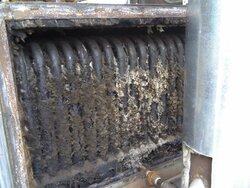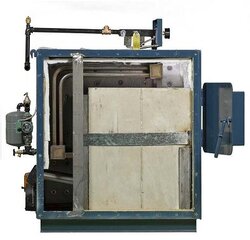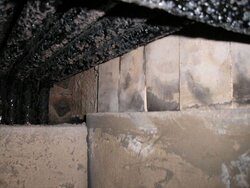Has anyone tried wraping insulation on the out side of your boiler? I thought I had heard of some one doing so and wondering if it helped the dripping from the sides?
Insulating Greenwood, Greenfire, Steaton,
- Thread starter Trzebs13
- Start date
-
Active since 1995, Hearth.com is THE place on the internet for free information and advice about wood stoves, pellet stoves and other energy saving equipment.
We strive to provide opinions, articles, discussions and history related to Hearth Products and in a more general sense, energy issues.
We promote the EFFICIENT, RESPONSIBLE, CLEAN and SAFE use of all fuels, whether renewable or fossil.
You are using an out of date browser. It may not display this or other websites correctly.
You should upgrade or use an alternative browser.
You should upgrade or use an alternative browser.
- Status
- Not open for further replies.
Deere10
New Member
Jesse-M
Member
I'm in the process of rebuilding mine now. Going to try something completely different with the insulation to where it wont be exposed to the elements of the fire. I don't like the way the insulation acts in the corners. ( collects creosote ) Basically what I'm doing would be like removing the insulation from the inside and wrapping the out side, only different. In my opinion it will work much better. I agree that long hot burns with no idle time would probably help this a bunch but I don't have storage and won't for some time. I'm documenting my rebuild and will post pics soon.
Im assuming you must have tried this and it has not worked (Pat & Deere)
Jesse I have wondered the same thing about those corners. I have only done one experement with some fire bricks
but did not have succcess. I would be very intrested in what you come up with.
Jesse I have wondered the same thing about those corners. I have only done one experement with some fire bricks
but did not have succcess. I would be very intrested in what you come up with.
Trzebs, I'm adding storage this season. The dripping comes from moisture in the wood released during idling. The only way I can think of to get rid of it is long hot burns, but more importantly, it should help keep your HX tubes much cleaner and efficient. I spent 4 hours cleaning my tubes last spring, they were plugged almost solid in the back vertical section section. I modified the back plate on my Seton so i can easily access the tubes without dismantling my plumbing, in case i want to clean the tubes during the heating season. i'm hoping, and anticipating, that my build-up will be minimal this year with storage and better dried wood.
pat
pat
Deere10
New Member
I have my GW100 apart now and found the same build up on these tubes. Last season was my first with this unit(may have not been cleaned before I got it). Planning on modifying the side panel so removal and cleaning may be done during season with ease,rather than a complete tear down.
Jesse-M
Member
Deere10 said:I have my GW100 apart now and found the same build up on these tubes. Last season was my first with this unit(may have not been cleaned before I got it). Planning on modifying the side panel so removal and cleaning may be done during season with ease,rather than a complete tear down.
This is my typical... one season build up on vertical tubes
Attachments
muleman51
Member
Looks just like mine looks every time I open it up. Biggest problem is finding insulation to put it back together. I only burn continous fires but mine still pluggs up. I have mine wrapped on the outside with 4" of sheet fiberglass insulation. this lowered the boiler room temp to the high 90*s so it helped some. Every year I look less forward to heating, sure was easier with the old aqua therm, just keep throwing in wood. Lots of luck with next season. Jim
Mine looks like that as well. But the wierd thing is that I really cant tell much difference in the preformance. Now with that being said. I clean it in the spring and really don't use much wood in the fall. And by thie time it cools down It has a fairly good coat on the tibes already. But one way would be to measure chimney temps. The heat would need to go some where and if it's not getting transford to the Hx I would think it would go up the stack. May be a good experiment. I realize where the moisture for dripping is coming from but what puzzles me is that since I put in the Insulated chimnney pipe in I get no dripping at all from the chimnney. All of it is coming from the sides. I really think that those upper corners where is bare insulation is contributing to that.
Jesse-M
Member
Mine doesn't perform any different either..... The only thing I do during the heating season is occasional knock off the buildup on the horizontal tubes I can reach from the fire box. I don't have any problem waiting on the back till the end of the season.
Looking at it today again, I'm toying with the idea of pouring up some fire brick meterial and making the sides higher and If possible evan go over the top of the Hx. I would think that should help. I've seen some poeple on here pouring there own.
Jesse-M
Member
Trzebs13 said:Looking at it today again, I'm toying with the idea of pouring up some fire brick meterial and making the sides higher and If possible evan go over the top of the Hx. I would think that should help. I've seen some poeple on here pouring there own.
Pourable refractory is available but if your thinking of doing this to keep the insulation from being exposed to the elements you'll have to completely seal it up, which could be difficult.
I'm not familiar with these boilers, is that fiber insulation exposed directly to the smoke?
If so it seems to me that the vapor barrier (steel skin) is on the wrong side of the insulation, from a builders perpective. It doesn't matter how dry the wood is, unless its turned to charcoal, any remaining hydrogen will burn to form water which will move into the insulation and condense on the cold surface of the steel.
If so it seems to me that the vapor barrier (steel skin) is on the wrong side of the insulation, from a builders perpective. It doesn't matter how dry the wood is, unless its turned to charcoal, any remaining hydrogen will burn to form water which will move into the insulation and condense on the cold surface of the steel.
I
ISeeDeadBTUs
Guest
benjamin said:It doesn't matter how dry the wood is, unless its turned to charcoal, any remaining hydrogen will burn to form water which will move into the insulation and condense on the cold surface of the steel.
No doubt tru, Ben J. But what are the alternatives?
I ask because my GW is semi-apart at the mo, and I am researching steel and insulation before the rest of the home-dwellers have me comitted for not turning on the heat.
What if the insulation was sandiched in SS wire mesh, leaving air space between the insulation and the skin? If the skin were SS and allowed to drain, wouldn't this prolong the life of the skins and the insulation?
Oh, and back to the OP . . . I can't see where exterior insulation would be much benefit. And if the unit is inside the residence - sucker :grrr: - then why bother to try to contain standby losses?
Jimbo
Jesse-M
Member
benjamin said:I'm not familiar with these boilers, is that fiber insulation exposed directly to the smoke?
Yes, here is aside shot showing the insulation.
Attachments
[quote author="ISeeDeadBTUs" date="1284821362
No doubt tru, Ben J. But what are the alternatives?
I ask because my GW is semi-apart at the mo, and I am researching steel and insulation before the rest of the home-dwellers have me comitted for not turning on the heat.
What if the insulation was sandiched in SS wire mesh, leaving air space between the insulation and the skin? If the skin were SS and allowed to drain, wouldn't this prolong the life of the skins and the insulation?
Jimbo[/quote]
The vapor barrier should be on the hot side of the wall, just look at your refridgerator and freezer. The steel skin is neatly sealed on purpose and the plastic inside has holes in strategic places to let the moisture pass (some use foam and don't bother).
Two options I have are exterior insulation to raise the temp of the steel above the dew point, not much is needed or you'll bake the paint off of the steel and smell it if its inside. Or add a steel liner inside the insulation that is tighter than the existing steel skin, probably a PITA.
No doubt tru, Ben J. But what are the alternatives?
I ask because my GW is semi-apart at the mo, and I am researching steel and insulation before the rest of the home-dwellers have me comitted for not turning on the heat.
What if the insulation was sandiched in SS wire mesh, leaving air space between the insulation and the skin? If the skin were SS and allowed to drain, wouldn't this prolong the life of the skins and the insulation?
Jimbo[/quote]
The vapor barrier should be on the hot side of the wall, just look at your refridgerator and freezer. The steel skin is neatly sealed on purpose and the plastic inside has holes in strategic places to let the moisture pass (some use foam and don't bother).
Two options I have are exterior insulation to raise the temp of the steel above the dew point, not much is needed or you'll bake the paint off of the steel and smell it if its inside. Or add a steel liner inside the insulation that is tighter than the existing steel skin, probably a PITA.
The vapor barrier should be on the hot side of the wall, just look at your refridgerator and freezer. The steel skin is neatly sealed on purpose and the plastic inside has holes in strategic places to let the moisture pass (some use foam and don't bother).
Two options I have are exterior insulation to raise the temp of the steel above the dew point, not much is needed or you'll bake the paint off of the steel and smell it if its inside. Or add a steel liner inside the insulation that is tighter than the existing steel skin, probably a PITA.[/quote]
I think we may be getting somewhere here. I agree with the idea that we need a vapor barrier on the inside. But, with that being said I think it has to be air tight or near air tight. But using steel for it all thou it may be the easiest I'm not so sure how long the life would be on that. But It would sure be easy enough while you had it apart. To go to a fab shop and have them take some heavy sheet stock and bend it up in a big U shape, that goes over your Hx and sits on the top of you refractory.
Two options I have are exterior insulation to raise the temp of the steel above the dew point, not much is needed or you'll bake the paint off of the steel and smell it if its inside. Or add a steel liner inside the insulation that is tighter than the existing steel skin, probably a PITA.[/quote]
I think we may be getting somewhere here. I agree with the idea that we need a vapor barrier on the inside. But, with that being said I think it has to be air tight or near air tight. But using steel for it all thou it may be the easiest I'm not so sure how long the life would be on that. But It would sure be easy enough while you had it apart. To go to a fab shop and have them take some heavy sheet stock and bend it up in a big U shape, that goes over your Hx and sits on the top of you refractory.
I
ISeeDeadBTUs
Guest
Sorry 13, I gotta disagree with ya again.
And if my understanding of Ben J was correct, he was saying the steel needs to be above the dewpoint. Though I've never measured the temp on the OUTSIDE (nor inside, but I assume inside would be hotter) I seriously doubt that when the H2O temp is 170 or higher the temp of the skins is below the dew point.
One thing I find curious is that any time I've removed a skin, I never find the insulation wet . . . :smirk:
And if my understanding of Ben J was correct, he was saying the steel needs to be above the dewpoint. Though I've never measured the temp on the OUTSIDE (nor inside, but I assume inside would be hotter) I seriously doubt that when the H2O temp is 170 or higher the temp of the skins is below the dew point.
One thing I find curious is that any time I've removed a skin, I never find the insulation wet . . . :smirk:
Well I would hope that you (Jimbo) would wait till the unit is cooled off before you've removed the sides. And I'm assuming that it's probably evaporated by the time you get to it. After thinking about this some more, I put some fire bricks and linned them vertical from the top of the refectory to the top of the interior. They fit nice and snug. I think what Ben brought up is a valid point. Here's the reality of this. All, not just our style of boilers, all are going to have at least 18-20 percent moisture content in the wood supply. To automatically blame wet wood is really a comp out, if you ask me. Sure the dryer the wood the less there will be, but there is still going to be allot of moisture in your wood. With that being said we need to focus on where it goes. Water turns to steam. Where the steam goes is the real problem. I don't want it soaking into the insulation period. I would like to direct it out and up the chimney. Not dripping down the sides. Now is that possible? I really don't know and thats what I'm trying to figure out.
If there's a will, there's a way. And the more of us thinking about it, and trying things I bet we'll get it!
If there's a will, there's a way. And the more of us thinking about it, and trying things I bet we'll get it!
Attachments
I don't claim to be an expert on condensation, but if these are dripping moisture, I'm guessing the problem is the design of the insulation allowing the steel to remain below the dew point for long enough to drip water out of the unit. Refractory may be a good solution also, it may lose more heat than the original insulation to do that.
Jesse-M
Member
Trzebs13 said:To go to a fab shop and have them take some heavy sheet stock and bend it up in a big U shape, that goes over your Hx and sits on the top of you refractory.
benjamin 18 September 2010 07:56 AM
Or add a steel liner inside the insulation that is tighter than the existing steel skin, probably a PITA
Now you guys are getting close to what I've got under way.....
Does anybody know what this is thats being advertised on the new Setons? " stainless steel evaporative condensate system "
................................................Found here................................................
Trzebs13 said:If you could tell me excatly what the "dew point" would be?
Probably around 200 degrees at the highest, unless something besides water condenses out of smoke that changes that temperature. You may be OK with temperatures much lower but I'm still thinking that the skin will be cool enough to condense water out of the smoke for a short time on every burn cycle.
Is this where the water is coming from and not condensing on the heat exchange pipes?
- Status
- Not open for further replies.
Similar threads
- Replies
- 5
- Views
- 942
- Replies
- 0
- Views
- 491
- Replies
- 0
- Views
- 955
- Replies
- 10
- Views
- 2K




